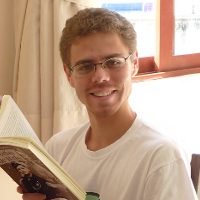 Dr. Yuri Alexandre Aoto




|
Obteve seu grau de Bacharel em Química pela Universidade de São Paulo (2008) e Doutorado em Química pela mesma instituição (2013), com bolsa do CNPq. Seu projeto consiste no estudo cinético por dinâmica quântica de reações contendo halogênio e enxofre, focando na influência da interpolação da superfície de energia potencial nos cálculos.
Received his Bachelor degree in chemistry by the Universidade de São Paulo (2008) and is PhD student in the same institution, with a grant from CNPq. His project consist in the kinetic study by quantum dynamics of reaction containing halogen and sulfur, focusing on the influence of the potential energy surface interpolation procedure in the calculations.
|
Publicações
Publications
 Yuri A. Aoto and F. R. Ornellas,
"Perimetric coordinate system in potential energy surfaces, spline interpolations, and the study of triatomic reaction dynamics",
Theor. Chem. Acc. 133, 1547 (2014).
Yuri A. Aoto and F. R. Ornellas,
"Perimetric coordinate system in potential energy surfaces, spline interpolations, and the study of triatomic reaction dynamics",
Theor. Chem. Acc. 133, 1547 (2014). A. G. S. de Oliveira-Filho, Y. A. Aoto and F. R. Ornellas,
"Full-dimensional analytical ab initio potential energy surface of the ground state of HOI",
J. Chem. Phys. 135, 044308 (2011). A. G. S. de Oliveira-Filho, Y. A. Aoto and F. R. Ornellas,
"Full-dimensional analytical ab initio potential energy surface of the ground state of HOI",
J. Chem. Phys. 135, 044308 (2011). Y. A. Aoto, A. G. S. de Oliveira-Filho, K. Franzreb and
F. R. Ornellas, "Metastable BrO2+ and NBr2+ molecules in the gas phase",
J. Chem. Phys. 134, 104303 (2011). Y. A. Aoto, A. G. S. de Oliveira-Filho, K. Franzreb and
F. R. Ornellas, "Metastable BrO2+ and NBr2+ molecules in the gas phase",
J. Chem. Phys. 134, 104303 (2011). Y. A. Aoto, A. G. S. de Oliveira-Filho and
F. R. Ornellas, "Isomers on the [H, S2, Cl] potential energy surface: a high-level investigation",
J. Mol. Sctruct. (THEOCHEM) 902, 90 (2009). Y. A. Aoto, A. G. S. de Oliveira-Filho and
F. R. Ornellas, "Isomers on the [H, S2, Cl] potential energy surface: a high-level investigation",
J. Mol. Sctruct. (THEOCHEM) 902, 90 (2009). T. V. Alves, Y. A. Aoto and F. R. Ornellas,
"Structural and spectroscopic properties of the diazocarbene radical (CNN) and its ions CNN+ and CNN-: a high-level theoretical
investigation",
Mol. Phys. 108, 2061 (2010). T. V. Alves, Y. A. Aoto and F. R. Ornellas,
"Structural and spectroscopic properties of the diazocarbene radical (CNN) and its ions CNN+ and CNN-: a high-level theoretical
investigation",
Mol. Phys. 108, 2061 (2010). A. G. S. de Oliveira-Filho, Y. A. Aoto and F. R. Ornellas,
"New molecular species of potential interest to atmospheric chemistry: isomers on the [H, S2, Br] potential energy surface",
J. Phys. Chem. A113, 1397 (2009). A. G. S. de Oliveira-Filho, Y. A. Aoto and F. R. Ornellas,
"New molecular species of potential interest to atmospheric chemistry: isomers on the [H, S2, Br] potential energy surface",
J. Phys. Chem. A113, 1397 (2009). Y. A. Aoto and F. R. Ornellas, "Predicting new molecular species
of potential interest to atmospheric chemistry: the isomers HSBr and HBrS",
J. Phys. Chem. A 111, 521 (2007). Y. A. Aoto and F. R. Ornellas, "Predicting new molecular species
of potential interest to atmospheric chemistry: the isomers HSBr and HBrS",
J. Phys. Chem. A 111, 521 (2007).
|






